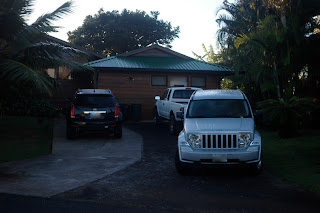Today was a very nice and also typical day in the emerging pattern of my daily life here in Kauai.
Awoke before daybreak (not due to cocks crowing though I did hear them) and got up, checked email, did yoga, and departed before 7am in early light for Kalaheo.
Breakfast at the Kalaheo Cafe -- veggie omelet with hash-browns and cornbread muffin, two cups coffee. A tourist just arrived on the island asked me where to see the sunrise (the sun was already up).
Drove down to the
NTBG -- the south side visitor center is in Poipu near Spouting Horn, but the garden administration, research, and support buildings are in Kalaheo and there is a back entrance to the same gardens from there at the back of the Lawai Valley. Stopped by the volunteer office to check in, commiserate about their attempts to use Facebook (which I couldn't help with at all), and buy a volunteer T-shirt.
Proceeded down into the garden first to see the
hale (traditional Hawaiian structure) currently under construction in the rear of the valley. I am hoping to be able to volunteer helping with the remaining construction tentatively planned for late this month.

Found George and got going weeding a section of the
Allerton garden. The Allerton is a fabulous garden -- I'll write all about it after I get a tour (gratis to volunteers) next week. Today I was weeding a relatively modest section [
map] of the garden where a collection of fruit trees were. One tree was tagged as a Black Apple which I had never heard of -- it was still small and not yet bearing fruit. My job was to pull weeds, primarily a white flowered vine, from the grassy area around the trees. The ground here is quite rocky so they can't mow it as they do a similar section nearby, hence, hand weeding is needed. To get the vines out by the root requires tracing them down through the thick grass to the ground and then yanking it the crown which is usually firmly attached to a chunk of lava gravel.
In a full day I got about 1/5 of this large area (above, right) weeded, but enough that it shows. The panoramic below is shot standing where I was weeding showing the road that runs around the fruit orchard. None of these pictures even begins to do justice to the Allerton: this was the set for Jurassic Park and Pirates of the Caribbean 3 movies.
Had lunch with George and learned a bit about the gardening work to keep the Allerton going. They are done to six (from eleven) full timers now and are constantly overwhelmed with the workload, but they do a great job.
 |
| Bird in tree right where I was working. |
After lunch, George took me on a short private tour all the way out to the beach where Allerton's house is situated and showed me all the old structures such as the greenhouse, destroyed by hurricane Iniki over twenty years ago. Later I rode along to dump the weeds I had piled up -- we went across to the west side of the stream and up, through two tunnels to the garden waste dump (still unclear why it's so distant). The dump is at the furthest usable part of an old road that used to lead to sugar cane fields further down the coast. With disuse the road has become overgrown with bougainvillea beyond where we dumped the weeds. The spot overlooks the house and beach and has got to be the most exotic and scenic garden waste pile in the world.
On the way back from the NTBG, I have made a habit of stopping by
Kauai Brewing (the western-most micro-brewery in the USA) for a draft -- I like the Cane Fire Red.
Next in Hanapepe I picked up some
Taro Ko chips -- purple sweet potato with
li hing mui (
salty dried plum) flavor. Stanley was low on product because their slicer is broken and until it's fixed they can't make more. They produce the chips right there in the little house-cum-factory. He always gives me an extra free bag when I buy there -- maybe he does for everyone?
Had fish tacos in Hanapepe at
Paco's Tacos (OK, not great). Then back to Waimea to shower and change and go for an early evening walk along the beach after sunset. The ocean has been very calm the last couple of days with waves hardly a foot tall if that gently rocking up and down the dark sand.
Not a bad day at all.
































